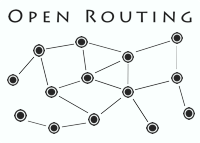LinkMonitor - Links Discovery¶
Introduction¶
LinkMonitor is the module interacts with the system to monitor link, aka,
interface status and addresses. It learns and monitor the link information from
Linux kernel through Netlink Protocol. Main functions of this module are:
Monitor system interface status & address;
Initiate neighbor discovery for newly added links;
Maintain KvStore peering with discovered neighbors;
Maintain
AdjacencyDatabaseof current node inKvStoreby injectingadj:<node-name>;
Inter Module Communication¶

[Producer] ReplicateQueue<thrift::InterfaceDatabase>: react toNetlinkevent update and asynchronously update interface database to informSparkto start/stop neighbor discovery on the updated interfaces.[Producer] ReplicateQueue<PrefixEvent>: populate redistributed interface information fromOpenrConfigand inject interface address information toPrefixManager, which is responsible for injecting prefixes intoKvStorefor propagation.[Producer] ReplicateQueue<thrift::PeerUpdateRequest>: populates PEER SPEC information toKvStorefor peer session establishment over TCP connection.[Producer] ReplicateQueue<KeyValueRequest>: send requests to set key-value storing node’s adjacency database inKvStore.[Consumer] RQueue<NeighborInitEvent>: receive neighbor update sent fromSparkor InitializationEventNEIGHBOR_DISCOVERED. Neighbor update events include neighbor UP/DOWN/RESTART/RTT-CHANGE. This info will finally lead to PEER SPEC propagation towardsKvStore.[Consumer] RQueue<fbnl::NetlinkEvent>: receiveNetlinkevent from underneath platform to add/delete/update interface information, which further populates update toSparkandPrefixManager.[Consumer] RQueue<KvStoreSyncEvent>: receive notification fromKvStoreto indicate state of initial full-sync. This helps with the graceful-restart(GR) case. See the later section for detail.
Operations¶
Typical workflow at a high level will be:
Link UP:
LinkMonitorreceives interface updates and expands the interface database. It will updateSparkfor neighbor discovery work.Sparksends back UP adjacency if any, which leads to adjacency key-value population towardsKvStore.
Link DOWN:
LinkMonitorreceives interface update and shrinks interface database.Sparkwill be updated and all established adjacency will be dropped. Finally, the neighbor DOWN event will be reported back;
NOTE:
LinkMonitormanages peering sessions ofKvStoreper peer. This means there will be ONLY one TCP session towards one unique node even there are parallel adjacencies between them.
Deep Dive¶
Link/Address Discovery¶
LinkMonitor relies on Netlink to directly fetch LINK/ADDRESS information
from Linux Kernel. See Netlink.md for detailed understanding. It leverages
fiber task to monitor update via reader queue for event notification.
LinkState Management¶
LinkMonitor provides public API to accept various commands for operation of
the link-state protocol. For example, to overload link/node to alter link-state
in the network. Sample APIs are:
SET/UNSET OVERLOAD=> Toggles transit traffic through nodeSET/UNSET LINK_OVERLOAD=> Toggles transit traffic through a specific linkSET/UNSET LINK_METRIC=> Customize metric value on a link for soft drainsDUMP_LINKS=> Retrieves the link information of a nodeDUMP_ADJS=> Retrieves the adjacency information of a node
Adjacency Event Throttling¶
LinkMonitor listens to Spark events (described below) (e.g. NEIGHBOR_UP,
NEIGHBOR_DOWN) and maintains the link-state of the local node. From there, it
gathers any customized link metrics and OVERLOAD bits for the node or any
link. Then it prepares the AdjacencyDatabase object for the node and keeps it
up to date in KvStore to let everyone else in the network be aware of any
link-state change.
NOTE: NEIGHBOR UP event goes through throttled fashion since we don’t want
KvStoresuffers from tremendous updates when a node is just started. However, NEIGHBOR DOWN event doesn’t do the same thing due to fast convergence requirement to avoid potential packet loss.
Link Events Dampening¶
Interfaces on systems are usually expected to be stable either UP or DOWN.
However for number of reasons the interface may go crazy and starts to flap e.g.
bad-optics, wireless medium hindrance. In such cases, we would like to avoid
control plane churn across the whole network, as nodes will try to route
through/around when the link is up/down. To avoid such a scenario, LinkMonitor
supports link-event dampening, which means exponential backoff is applied to the
link if it flaps. As the name suggests, back-off time will be 2x the previous
backoff period until it reaches max_backoff_ms. If the link shows stability
within a period, it is enabled for neighbor discovery.
You can configure backoffs for link event dampening with LinkMonitorConfig.
struct LinkMonitorConfig {
1: i32 linkflap_initial_backoff_ms = 1000 # 1s
2: i32 linkflap_max_backoff_ms = 8192 # 8.192s
...
}
Link Metric¶
LinkMonitor is responsible for computing the metric value for each adjacency
to neighbors which are then used to compute the cost of a path in Decision’s
SPF computation. For now, we support two kinds of metrics:
[by default]
hop_count=> Use1(constant) metric value for each Adjacency[by config knob]
rtt_metric=>rtt_us / 100wherertt_usis measured rtt in microseconds.
NOTE:
rttis measured dynamically bySparkas part of neighbor discovery and keep-alive mechanisms. RTT changes are observed handled dynamically.
Segment Routing Support¶
To Support Segment Routing, LinkMonitor injects:
Node Label by leveraging
RangeAllocatorto assign a globally unique label across the network(viaKvStoreto detect collision);Adjacency Label by leveraging
Sparkto assign a unique label derived from ifIndex;
NOTE: Adjacency Label is locally unique per node.
